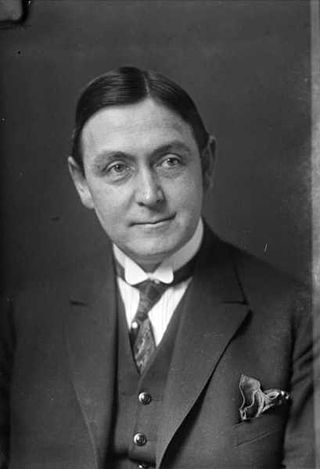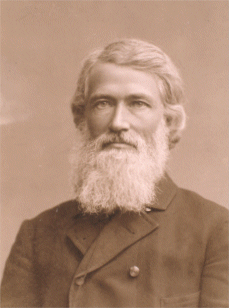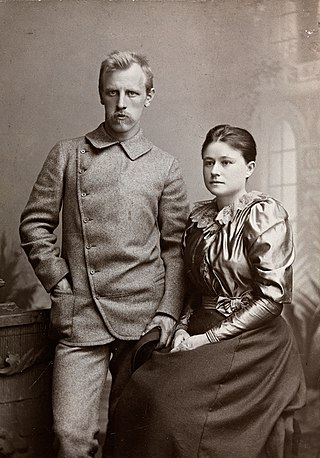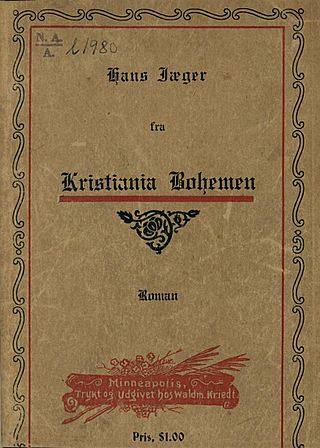Related Research Articles
Events in the year 1933 in Norway.

Gerhard von der Lippe Gran was a Norwegian literary historian, professor, magazine editor, essayist and biographer.
Anders Krogvig was a Norwegian librarian, writer, literary consultant and critic.

Edvard Bull was a Norwegian historian and politician for the Labour Party. He took the doctorate in 1912 and became a professor at the University of Kristiania in 1917, and is known for writings on a broad range of subjects. In addition to his academic work, he is known for his work on Norsk biografisk leksikon. His Marxist leanings inspired him to take up a parallel political career, in the Labour Party. Situated on the radical wing in the 1910s, he was among the architects as the Labour Party denounced the Twenty-one Conditions in 1923 and reunited with the social democrats in 1927. He was the deputy party leader from 1923 to 1932, and served as Norwegian Minister of Foreign Affairs in Hornsrud's short-lived cabinet in 1928.

Jens Fredrik Wilhelm Schroeter was a Norwegian astronomer.

Francis Bull was a Norwegian literary historian, professor at the University of Oslo for more than thirty years, essayist and speaker, and magazine editor.

Edvard Freydar Beyer was a Norwegian literary historian, literary critic, and professor at the University of Oslo from 1958 to 1990.
Åse Hiorth Lervik was a Norwegian literary researcher.

Johan Christian Schreiner was a Norwegian historian. He was a professor at the University of Oslo, and his speciality was the Middle Ages.

Johan Ernst Welhaven Sars was a Norwegian professor, historian, author and editor. Assuming perspectives from the positivism philosophical school, his main work was Udsigt over den norske Historie, four volumes issued from 1873 to 1891. He co-edited the magazines Nyt norsk Tidskrift from 1877 to 1878, and Nyt Tidsskrift from 1882 to 1887. He was politically active for the Liberal Party of Norway and among the party's most central theoreticians.
Anders Daae was a Norwegian-American physician.
Edvard Welle-Strand was a Norwegian journalist and novelist.

Eva Helene Nansen was a celebrated Norwegian mezzo-soprano singer. She was also a pioneer of women's skiing.
Paul Gruda Koht was a Norwegian diplomat.

Øyvind Anker was a Norwegian librarian.
Nyt Tidsskrift is a former Norwegian literary, cultural and political periodical issued from 1882 to 1887, and with a second series from 1892 to 1895. The periodical had contributions from several of the leading intellectuals of the time, including later Nobel Literature Prize laureate Bjørnstjerne Bjørnson, later Nobel Peace Prize laureate Fredrik Bajer, the writers Alexander L. Kielland, Jonas Lie, Arne Garborg and Hans Aanrud, proponents for women's rights Camilla Collett, Gina Krog and Hagbard Emanuel Berner, and painter Erik Werenskiold.

Hans Tambs Lyche was a Norwegian engineer, Unitarian minister, journalist, and magazine editor.

Fra Kristiania-Bohêmen is a novel from 1885 by Norwegian writer Hans Jæger. The book was confiscated shortly after its publication, and Jæger was sentenced to prison and lost his position as stenographer at the Parliament.
References
- ↑ "Edda [electronic resource] nordisk tidsskrift for litteraturforskning". Princeton University Library. Retrieved 23 April 2020.
- ↑ Petter Henriksen, ed. (2007). "Edda – tidsskrift". Store norske leksikon (in Norwegian). Oslo: Kunnskapsforlaget.
- ↑ Sigurd Aa Aarnes. "Gerhard Gran". In Knut Helle (ed.). Norsk biografisk leksikon (in Norwegian). Oslo: Kunnskapsforlaget.
- ↑ Knut Helle (ed.). "Francis Bull". Norsk biografisk leksikon (in Norwegian). Oslo: Kunnskapsforlaget.
- ↑ Atle Kittang. "Edvard Beyer". In Knut Helle (ed.). Norsk biografisk leksikon (in Norwegian). Oslo: Kunnskapsforlaget.
- ↑ Petter Henriksen, ed. (2007). "Åse Hiorth Lervik". Store norske leksikon (in Norwegian). Oslo: Kunnskapsforlaget.
- ↑ P. M. Mitchell (August 1962). "Contemporary Danish Criticism: Media, Methods and Men". Scandinavian Studies. 34 (3): 159. JSTOR 40916395.
- ↑ Thisted, Kirsten (2001). Unni Langås; Andreas G. Lombnæs; Jahn Thon (eds.). "Stepping off the map? Grønlandsk litteratur mellem globalisering og nation". Edda (in Danish) (4). Oslo: Universitetsforlaget: 419–436.
- ↑ Graves, Peter (2006). Ole Karlsen; Lisbeth Pettersen Wærp; Henning Howlid Wærp (eds.). "The Howitts, English Identity and Scandinavian Literature ca 1850". Edda (3). Oslo: Universitetsforlaget: 243–253.